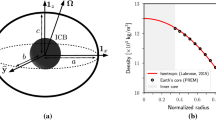Abstract
Geophysicists have developed a perspective on the dynamical influence of Earth’s rotation, while most other areas of fluid dynamics can safely disregard rotation. In this essay the dominant turbulence and wave behaviors in the rotating and non-rotating fluid-dynamical realms are described, and particular attention is given to their borderlands, where rotational influences are significant but not dominant. Contrary to the inverse energy cascade of geostrophic turbulence toward larger scales, a forward energy cascade toward microscale dissipation develops within the borderlands from the breakdown of diagnostic force balances, frontogenesis, and frontal instabilities, and then it continues further through the small-scale non-rotating realm until it dissipates at the microscale.
Similar content being viewed by others
References
Boccaletti G, Ferrari R, Fox-Kemper B (2007) Mixed layer instabilities and restratification. J Phys Oceanogr 37: 2228–2250
Capet X, McWilliams JC, Molemaker MJ, Shchepetkin A (2008) Mesoscale to submesoscale transition in the California Current System: (I) flow structure, eddy flux, and observational tests. J Phys Oceanogr 38:29–43. (II) Frontal processes. J Phys Occanogr 38:44–64. (III) Energy balance and flux. J Phys Oceanogr (in press)
Charney JG (1971) Geostrophic turbulence. J Atmos Sci 28: 1087–1095
Gent PR, McWilliams JC (1990) Isopycnal mixing in ocean circulation models. J Phys Oceanogr 20: 150–155
Gregg MC (1989) Scaling turbulent dissipation in the thermocline. J Geophys Res 94: 9686–9698
Henyey FS, Wright J, Flattè SM (1986) Energy and action flow through the internal wave field: an eikonal approach. J Geophys Res 91: 8487–8496
Holliday D, McIntyre ME (1981) On potential energy density in an incompressible, stratified fluid. J Fluid Mech 107: 221–225
Hoskins BJ (1974) The role of potential vorticity in symmetric stability and instability. Q J R Meteorol Soc 100: 480–482
Hoskins BJ, Bretherton FP (1972) Atmospheric frontogenesis models: mathematical formulation and solution. J Atmos Sci 29: 11–37
Julien K, Legg S, McWiliams J, Werne J (1996) Penetrative convection in rapidly rotating flows. Dyn Atmos Oceans 24: 237–249
Laval JP, McWilliams JC, Dubrulle B (2003) Forced stratified turbulence: successive transitions with Reynolds number. Phys Rev E 68:036308, 1–8
Lilly DK (1983) Stratified turbulence and the mesoscale variability of the atmosphere. J Atmos Sci 40: 749–761
Lindborg E (2005) The effect of rotation on the mesoscale energy cascade in the free atmosphere. Geophys Res Lett 32:L01809, 1–4
Lindborg E (2006) The energy cascade in a strongly stratified fluid. J Fluid Mech 550: 207–242
Lorenz EN (1955) Available potential energy and the maintenance of the general circulation. Tellus 7: 157–167
McWilliams JC (2003) Diagnostic force balance and its limits. In: Velasco Fuentes OU, Sheinbaum J, Ochoa J(eds) Nonlinear processes in geophysical fluid dynamics. Kluwer Academic Publishers, Dordrecht, pp 287–304
McWilliams JC, Gent PR (1980) Intermediate models of planetary circulations in the atmosphere and ocean. J Atmos Sci 37: 1657–1678
McWilliams JC, Weiss JC, Yavneh I (1994) Anisotropy and coherent structures in planetary turbulence. Science 264: 410–413
McWilliams JC, Yavneh I, Cullen MJP, Gent PR (1998) The breakdown of large-scale flows in rotating, stratified fluids. Phys Fluids 10: 3178–3184
Molemaker MJ, McWilliams JC (2008) APE spectrum and spectral budget in rotating, stratified flows. J Fluid Mech (submitted)
Molemaker MJ, McWilliams JC, Capet X (2008) Balanced and unbalanced routes to dissipation in an equilibrated Eady flow. J Fluid Mech (submitted)
Molemaker JM, McWilliams JC, Yavneh I (2005) Baroclinic instability and loss of balance. J Phys Oceanogr 35: 1505–1517
Müller P, McWilliams JC, Molemaker MJ (2005) Routes to dissipation in the ocean: the 2D/3D turbulence conundrum. In: Baumert H, Simpson J, Sundermann J(eds) Marine turbulence: theories, observations and models. Cambridge University Press, Cambridge, pp 397–405
Riley JJ, deBruynKops SM (2003) Dynamics of turbulence strongly influenced by buoyancy. Phys Fluids 15: 2047–2059
Thomas L, Lee C (2005) Intensification of ocean fronts by down-front winds. J Phys Oceanogr 35: 1086–1102
Waite ML, Bartello P (2006) The transition from geostrophic to stratified turbulence. J Fluid Mech 568: 89–108
Yavneh I, Shchepetkin AF, McWilliams JC, Graves LP (1997) Multigrid solution of rotating, stably stratified flows: the balance equations and their turbulent dynamics. J Comput Phys 136: 245–262
Author information
Authors and Affiliations
Corresponding author
Rights and permissions
About this article
Cite this article
McWilliams, J.C. Fluid dynamics at the margin of rotational control. Environ Fluid Mech 8, 441–449 (2008). https://doi.org/10.1007/s10652-008-9081-8
Received:
Accepted:
Published:
Issue Date:
DOI: https://doi.org/10.1007/s10652-008-9081-8




